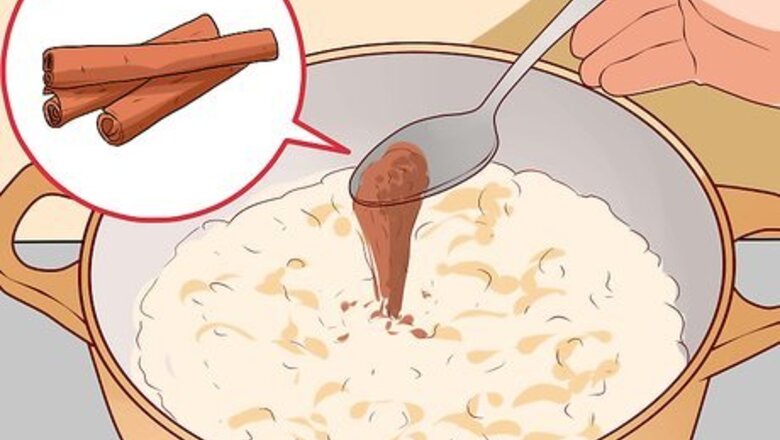
views
Incorporating Cinnamon Into Your Diet
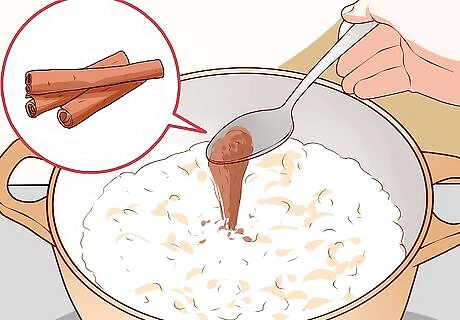
Use cinnamon to replace sugar. Because cinnamon is so flavorful, it can often replace small amounts of sugar in stove-top recipes, sauces, meat, and vegetable dishes. Replacing a sweetener with this spice can help reduce the amount of sugar you consume and improve your blood glucose levels. Cinnamon is considered safe when used in the amounts normally found as foods-- this works out to roughly ½ to 1 teaspoon or about 1000 mg per day.

Add cinnamon to your breakfast. For instance, stir cinnamon and a small amount of agave nectar into oatmeal in the morning, adding berries and nuts to make it an even more nutritious breakfast. Or top off buttered whole grain toast with a dash of cinnamon and a sprinkle of a crystallized sweetener like Stevia or Splenda. Cinnamon also goes well with peanut butter or sugar-free jam on toast.
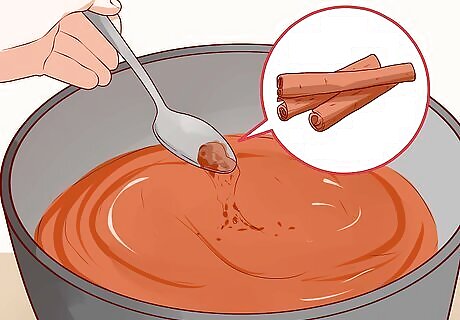
Use cinnamon in meat sauces. Cinnamon pairs well with poultry, pork, and beef spice rubs as well as Asian-themed dishes, marinades, and salad dressings. Mixing to taste, replace some of the sugar or brown sugar with cinnamon for homemade barbecue sauces, pulled pork marinade, berry compotes, and even marinara sauces.
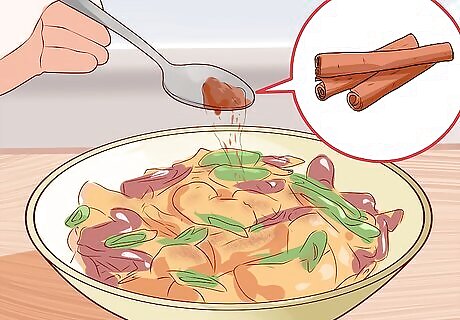
Replace sugar in vegetable dishes. Use cinnamon in place of brown sugar or regular sugar in candied vegetable dishes, such as candied yams, baby carrots, or sweet stir fry. Cinnamon lends a complex, sweet flavor without the spike in glucose.

Use cinnamon in baking. Baking is perhaps the easiest way to incorporate more cinnamon into your diet. If you enjoy homemade breads, muffins, breakfast bars, cookies, or pies, cinnamon can be easily added to virtually any recipe you love. Stir cinnamon into baked good recipes. Extra cinnamon mixes best with dry flour. If a recipe already calls for some cinnamon, try doubling the amount! You can always cut back on the amount of nutmeg in a recipe and replace it with cinnamon. Use cinnamon to dust baked goods. If cinnamon has already been incorporated into a baked good recipe, try using a baker’s brush or sifter to lightly dust the top.
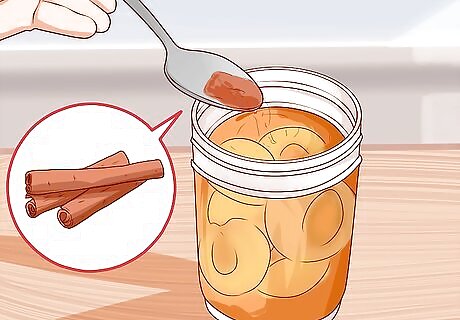
Add cinnamon to sweet and savory canning recipes. Canning fruits and vegetables offers an easy way to sneak cinnamon into snacks and sides that otherwise would be free of cinnamon. When used appropriately, cinnamon can make an excellent addition to sweet and savory canning recipes. Use cinnamon heavily in recipes like apple or pumpkin butter, canned apples, and applesauce. Add a 1/4 teaspoon of cinnamon to each large Mason jar of other fruits, like canned peaches or strawberries. If you are canning or pickling savory foods, consider adding cinnamon with cucumbers, green beans, onions, beets, and even bell peppers.
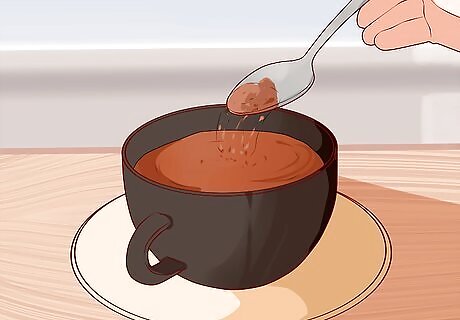
Use cinnamon in drinks. Try adding a little cinnamon to your coffee grounds in the morning to get a cinnamon-flavored cup of caffeine, or mix it into smoothies, diet shakes, and dairy-based blended drinks to get an extra dose of cinnamon in your day.
Adding a Cinnamon Supplement to Your Treatment Regimen
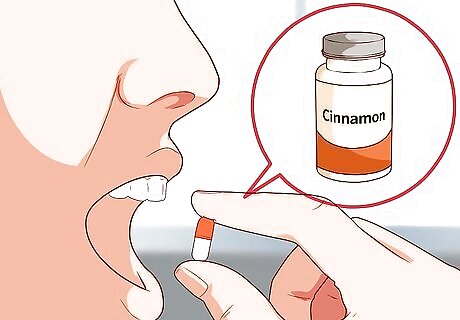
Consider taking a cinnamon supplement. If you don't want to add cinnamon to your meals, you can still add it to your diet by taking a supplement. Many health supplement and natural food stores sell cinnamon supplements at affordable prices.

Talk to your health professional about adding a cinnamon supplement. While a low-dose cinnamon supplement is unlikely to harm you, your medical advisor may be aware of potential interaction effects with your medications that would make it risky to take cinnamon regularly. It can interact with your diabetes medications, as both the cinnamon and the hypoglycemics work to lower your blood sugar and it is important to be certain that your blood glucose levels drop too low. Keep track of how much cinnamon you are taking and keep track of your blood sugar levels using a home glucose monitor.

Consider a supplement of 500mg of cinnamon per day. 500 mg of cinnamon taken twice a day has been shown to improve A1c levels (and the levels of blood fats). A1c is used to determine average glucose levels for the previous 3 months, thus lowered A1c levels reflect improved diabetic control.
Understanding Why Cinnamon Helps with Diabetes

Learn about diabetes. Diabetes is a group of chronic hormonal disorders that results in too much sugar (glucose) in the blood. Type 1 diabetes is an autoimmune disorder, usually appearing when a person is young. Type 2 diabetes is an acquired disorder, and it’s the most common form of diabetes. A third form of diabetes is called gestational diabetes and occurs in the second half of pregnancy and is relatively common, occurring in less than 10% of pregnant people. Some physicians include pre-diabetes as an early form of diabetes. Individuals with prediabetes have higher than normal levels of blood glucose, but not high enough to be diagnosed as diabetics. Individuals with pre-diabetes (also known as insulin resistance) have a very high risk of developing type 2 diabetes.
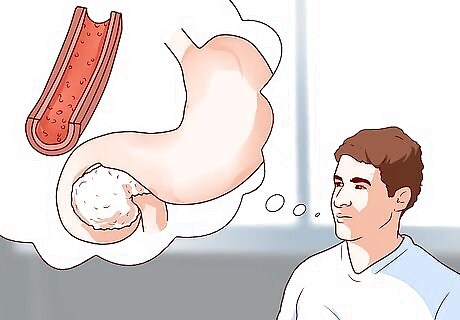
Investigate how insulin affects blood sugar. Insulin, a hormone produced by the pancreas, is the main chemical messenger that “tells” the cells that it is time to take up glucose. Insulin is involved in messaging the liver to take up glucose and transform it into the storage form of glucose known as glycogen. Insulin is also involved in a wide range of other functions like protein and fat metabolism. All diabetics can also be said to have insulin resistance. The reason they have high blood glucose is that the cells in their body do not take up glucose. If the cells become insulin resistant, they “ignore” or can’t respond to the signal from insulin. This can increase the levels of glucose in the blood. The problem is that since the insulin has no effect on the insulin-resistant cells, the blood glucose levels can keep rising. This results in chronic inflammation and potentially, diabetes.

Understand how Type 2 diabetes functions and its traditional treatment. The most common symptoms of Type 2 diabetes include: increased thirst along with more frequent urination, increased appetite, weight gain or unexpected weight loss, blurry or changed vision, fatigue, and increased number of infections. Type 2 diabetes is diagnosed by your symptoms and a number of specific blood tests that measure how well your body handles sugars. Most cases of diabetes can be controlled with a combination of medications (hypoglycemics -- medicines that lower blood sugars), diet, and exercise. Insulin may be ordered for some patients, especially those with Type 1 diabetes.

Find out why cinnamon can help control Type 2 diabetes. Current research indicates that one of the components of cinnamon, methyl hydroxychalcone polymer or MHCP, can improve how cells respond to insulin. MHCP also has antioxidant effects, though it is not clear that these have anything to do with the ability of cinnamon to control blood glucose. MHCP seems to mimic some of insulin’s activity. It also appears to work alongside insulin, by improving the effectiveness of insulin.















Comments
0 comment